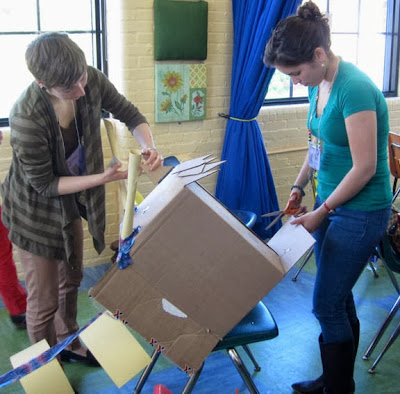In this country, saying that someone is a professional playworker will get you blank stares, dubious looks, maybe even snickers. But in the United Kingdom, playwork – the art of supporting children’s play without directing it – is a recognized and respected profession, practiced in playgrounds, housing projects and childcare programs.
 |
| Adventure playground in Berkeley, CA |
The concept of playwork originated in Europe following World War II, when children reclaimed their devastated communities by playing amid the wreckage and rubble. This inspired the creation of “adventure playgrounds,” play environments that kids can shape and reinvent by manipulating loose parts, as well as the role of playworker. Playworkers create play-rich environments, in which their presence is nearly invisible and where children freely pursue their own play, take as much risk as they can handle, solve their own conflicts, and play the way they want to for their own reasons.
Playworkers understand that all children need to play, that play is an innate impulse and is critical for healthy development. They provide open-ended environments and loose parts – elements that encourage children to choose their own play activities and narratives – and see risk taking as a positive and necessary part of kids’ play.
Playworkers describe play as “a process that is freely chosen, personally directed and intrinsically motivated.” In other words, they have no agenda for children’s play. They are not coaches training kids in athletic skills. There is no game to win unless the kids themselves organize one. They are not teachers with a curriculum to “cover” or even informal educators hoping that, by building and testing kites or puff mobiles, kids will learn something about wind power. If kids decide to make and fly kites, a playworker will take note of their endeavor. She’ll offer some materials good for kite making and ensure the kite-flying field is free of hazards like broken glass or electric wires. If the kids have organized some sort of ball game, she will help them figure out ways to include the child whose disability prevents him from throwing a ball. If a child seems unsure of how to play in an open-ended non-directive environment, the playworker might model playing, packing a mud pie herself and casually decorating it with sticks and grasses.
To respond to and extend children’s play, playworkers carefully and constantly observe kids at play so they can make good decisions about intervening – or not. And they reflect on what they observe and their own responses. “Reflective practice” also involves documenting and sharing these reflections with fellow playworkers and tapping into personal childhood memories of play. As a result, a playworker is really attuned to the play – not leading or interfering with it at all but aware of its rhythms and nuances.
Interest in playwork is growing in the US and its techniques are beginning to be employed in parks, during school recess and at children’s museums. At Providence Children’s Museum, we’ve been studying and experimenting with playwork practices both in the Museum and in our outreach initiatives. We hosted workshops with two British playworkers last spring and are excited to welcome a third this month.
Join us to learn more about playwork during a talk and training with renowned London playworker Penny Wilson and Joan Almon of the Alliance for Childhood on Wednesday, September 25, about how to restore play for children of all abilities and socio-economic backgrounds. Click here for more information and to register.
 |
| Museum staff at a spring playwork training |



No comments:
Post a Comment